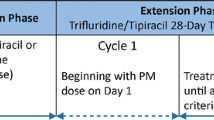Abstract
Purpose: The purpose of this randomized, two-period crossover study was to determine the pharmacokinetics of orally administered topotecan in the presence and absence of oral ranitidine. Methods: Patients with solid malignant tumors refractory to standard treatment were given topotecan orally on a daily times five schedule repeated every 21 days. Topotecan was given initially at 2.3 mg/m2 per day; dose adjustments were permitted after the first dose of course 2 if necessary. Blood samples for pharmacokinetic assessments were drawn at protocol-specified times for up to 10 h following oral administration of topotecan on day 1 of courses 1 and 2. Patients were randomly assigned to receive a total of nine doses of ranitidine: 150 mg twice daily for 4 days before day 1 of one of the first two courses and 150 mg given 2 h before the first topotecan dose. Plasma samples were assayed for concentrations of active topotecan lactone (TPT-L) and total topotecan (TPT-T, lactone plus open-ring carboxylate form) using high-performance liquid chromatography with fluorescence detection. After completion of courses 1 and 2, patients could continue on therapy for days 1–5 of every 21 days if not withdrawn due to unacceptable toxicity, disease progression, protocol violation, or by request. Patients continued on treatment for a maximum of six courses. Results: No pharmacokinetic parameter for either TPT-L or TPT-T differed significantly during administration of topotecan with ranitidine compared with topotecan alone (n=13). Geometric mean ratios (95% confidence intervals, CIs) of areas under the curve in the presence and absence of ranitidine were 0.94 (0.80, 1.10) for TPT-L and 0.97 (0.80, 1.16) for TPT-T. Corresponding ratios (CIs) of peak plasma concentrations in the presence and absence of ranitidine were 1.06 (0.78, 1.44) for TPT-L and 1.07 (0.84, 1.38) for TPT-T. The median difference in time to peak plasma concentration was 0.0 h for TPT-L and −0.5 h for TPT-T (i.e. slightly faster in the presence of ranitidine). Conclusions: Administration of ranitidine prior to oral topotecan resulted in a similar extent of absorption. A slightly faster rate of absorption of topotecan was also observed, which is unlikely to be of clinical significance. Dosage adjustments of orally administered topotecan should not be necessary in patients who are pretreated with ranitidine, an H2 antagonist, or another agent that comparably raises gastric pH.
Similar content being viewed by others
Author information
Authors and Affiliations
Additional information
Received: 8 September 1999 / Accepted: 5 April 2000
Rights and permissions
About this article
Cite this article
Akhtar, S., Beckman, R., Mould, D. et al. Pretreatment with ranitidine does not reduce the bioavailability of orally administered topotecan. Cancer Chemother Pharmacol 46, 204–210 (2000). https://doi.org/10.1007/s002800000141
Issue Date:
DOI: https://doi.org/10.1007/s002800000141




